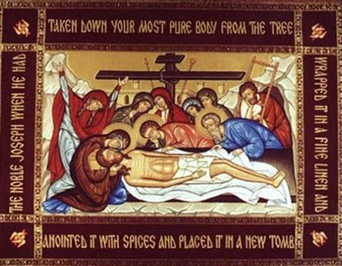EPITAPHIOS

The EPITAPHIOS (GR: epitaphios, or epitaphion; AR: نعش, naash; SL Plashchanitsa — a “Shroud.”) literally means “winding-sheet”, and is used in services of Holy Friday and Holy Saturday to re-present the burial and funeral of Christ. It is an icon made of cloth and richly embroidered (burgundy is the most common colour, often edged in gold fringe), depicting the body of The Saviour being laid in the grave. The scene is taken from the Gospel of John (19:38-42). Shown around Christ and mourning His death, may be his mother, The Theotokos; John the beloved disciple; Joseph of Arimathea; and Mary Magdalene, as well as angels. Nicodemus and others may also be depicted. Sometimes, the body of Christ appears alone, except for angels, as if lying in state. Usually, the troparion of the day is embroidered in gold letters around the edges of the icon: ‘’The Noble Joseph, taking down Thy most pure Body from the Tree, did wrap it in clean linen with sweet spices, and he laid it in a new tomb.’’ On the afternoon of Great Friday, the priest places the EPITAPHIOS on the Holy Table. He may also anoint it with perfumed oil. A chalice veil and the Gospel Book is placed on top of the EPITAPHIOS. Near the end of the service, the priest and deacon, accompanied by acolytes with candles and incense, bring the EPITAPHIOS in procession from the Holy Table into the center of the church and place it on a table which is often richly decorated for that purpose. The Gospel Book is laid on top of the EPITAPHIOS. On Holy Friday night, at the end of the Great Doxology, while the Trisagion Hymn is sung, the EPITAPHIOS is carried in a procession representing the funeral of Christ. At the end of the procession, it is brought back to the church. Sometimes, after the clergy carry the EPITAPHIOS in, they will stop just at the entrance of the church, and hold it above the door, so that all who enter the church will pass under it (symbolically entering into the grave with Christ) and then kiss the Gospel Book. The EPITAPHIOS is then brought directly to the sanctuary, where it remains on the Holy Table throughout the Paschal season.
ÉPITAPHIOS
L'Épitaphios (GR : epitaphios, ou epitaphion ; SL : plashchanitsa ; AR : نعش, naash) - Voile ou étoffe brodée, icône de la mise au tombeau du Christ et des lamentations de la Mère de Dieu, de Saint Jean, de Joseph d’Arimathie et de Nicodème. L'icône représente le Christ après qu'Il est descendu de la croix, couché, comme si Son corps était en cours de préparation pour l'enterrement. La scène est tirée de l'Évangile de saint Jean (19:38-42). Autour de Lui, en deuil, sont présents : Sa mère, la Théotokos, Jean le disciple bien-aimé, Joseph d'Arimathie, Marie-Madeleine, ainsi que des anges. Nicodème et d'autres peuvent également être représentés. Parfois, le corps du Christ apparaît seul, accompagné de la seule présence des anges. Habituellement, le tropaire du jour est brodé en lettres dorées sur les bords de l'icône : ‘’Le noble Joseph descendit de la Croix ton corps très pur, l’enveloppa d’un linceul immaculé, et le déposa, couvert d’aromates, dans un sépulcre neuf.’’ Le Grand Vendredi Saint débute avec la lecture des Heures Royales qui nous mènent aux Vêpres, lorsqu’on célèbre la déposition du corps du Christ de la Croix. Le prêtre dépose le Corps du Christ, il L’enveloppe dans un tissu blanc et le reporte, en procession, dans l’autel. Il peut également l'oindre avec de l'huile parfumée. Le voile du calice et l'Évangéliaire sont placés au-dessus de l'ÉPITAPHIOS. Vers la fin du service, le prêtre et le diacre, accompagnés d'acolytes avec des bougies et de l'encens, amènent l’ÉPITAPHIOS en procession de la Sainte Table au centre de l'église avant de le placer dans le Sépulcre qui symbolise le Tombeau du Christ. Le Livre de l'Évangile est alors posé au-dessus de l'ÉPITAPHIOS. Le Vendredi Saint soir, à la fin de la Grande Doxologie, tandis que le Trisagion est chanté, l'ÉPITAPHIOS est porté en procession représentant les funérailles du Christ. Il est ensuite ramené à l'église; le clergé s'arrête juste à l'entrée de l'église et le tient de sorte que tous ceux qui y entrent passent sous l'ÉPITAPHIOS (entrant symboliquement dans la tombe avec Christ), puis embrassent le livre de l'Évangile. L'ÉPITAPHIOS est alors amené directement au sanctuaire, où il reste sur la Sainte Table tout au long de la saison pascale.